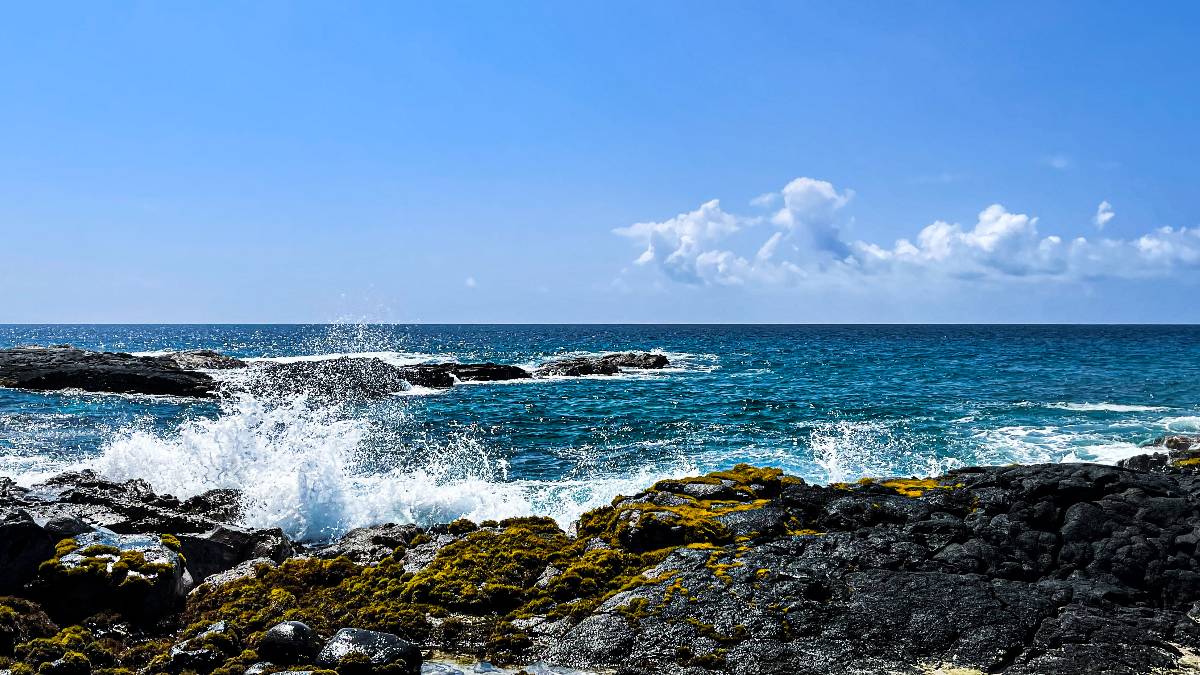What Color is Your Beach?
White? Black? Green?
The sand in Hawai’i is made up of a variety of things, for example, volcanic materials, dead marine organisms or green olivine crystals. On the windward side of the island, it is common to see black sand beaches. Yet, on the beach down at South Point, the sand is almost entirely green. While most of the beaches are made up of a mixture of different components, each beach is distinctive and has its own unique characteristics that make it so.
How does the sand turn black or what makes it black? Hawaii’s black sand is made of basalt and is created when lava flows into the ocean, almost always immediately creating an explosion that turns the hot lava into glass or black lava sand as it hits the water and cools. Black sand beaches teach us of the amazing force and powerful effects of what happens as hot molten lava meets salty sea water.
Punalu’u Beach Park, or Black Sand Beach as it is known, is an example of this type of black sand. Because of its ability to retain heat, black sand beaches are a favorite location for both the endangered hawksbill and green turtles to bask and lay their eggs.
There is something to be said about the beauty of black sand beaches. The sand can vary in size, but it is breathtaking to see as they seem to shine and glitter when wet. For some unknown reason to most of us, this type of sand loves to stick to your feet, legs, arms, and clothes. Remember to bring your “slippers” or footwear when visiting a black sand beach as they tend to retain their heat or even get hotter than your lighter colored sandy beaches.
Waipi’o Valley’s mile-long black sand beach is beautiful, as well as sacred. Upon closer examination, one might notice white grains of sand mixed in with the black grains of sand. One long time resident of the valley who asked to remain anonymous told us that he once took some of the sand to be analyzed and it was discovered that some (not all) of the white grains of sand are actually human bone. He recalls his kupuna telling him about bone fragments in the sand. They told him it came from the sacrificial heiau near the beach. It is best to keep this information in mind when visiting this beach as many of the local residents are protective of this beach.
So how do we get green sand you ask? Olivine deposits in the soil in areas of South Point create a green glow in the sand and cliff area. As sun hits this beach at mid-day, it is breathtaking to see the glow of the wet green sand. One might say it might be more accurate to call this green crystal beach. Thanks, but we’ll stick to Green Sand Beach or Papakōlea Beach (also known as Green Sand Beach or Mahana Beach). Whatever you call it, remember it is not recommended and actually against the law to remove sand from this beach or any other beach in the state of Hawai’i.
The Hawai’I Tourism Authority website description of Hawai’i Island beaches states: “Hawai’i Island features some of the most picturesque and varied beach landscapes in the islands. Here you’ll find not just white sand beaches but black sand and green sand beaches with olivine crystals. And along with beautiful resort beaches, Hawai’i Island also has rugged, off-the-beaten-path sands that are wild, remote and rewarding.”
Beaches help to transport us from the hustle and bustle of this crazy world, and for the most part, soothes our spirits and rejuvenates our souls. It is no wonder that many musicians choose to write songs about sandy beaches here in Hawai’i.
Ziggy Marley sings: “I wish you were here with me, walking on the beach in Hawai’i
Playing on the golden sand… and I wish you were here with me. On the beach in Hawai’i” Then you have Isreal Kamakawiwo’ole, who sings about being on the sandy beach with someone he loves in his song, “White Sandy Beach of Hawai’i.” Whatever song you decide to listen to or sing as you sit on the beach here in Hawai’i, remember it is of the utmost importance that we all do our part to help preserve it not just for ourselves, but for the future generations. Please kokua and don’t litter. It’s a beach, not an ashtray. Consider this our public service anouncement.
And now, it’s time for so fun in the sun on a sandy beach! What color shall it be today?
This article is part of a weekly BigIslandNow.com series by KAPA Hawaiian FM personality Darde Gamayo.
















